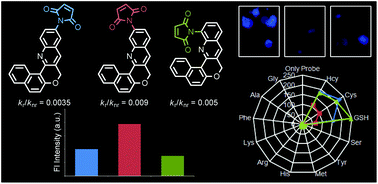Chromenoquinoline-based thiol probes: a study on the quencher position for controlling fluorescent Off–On characteristics†
Abstract
The design, synthesis and

* Corresponding authors
a
Department of Chemistry, Dmitri Mendeleev Block, Indian Institute of Science Education and Research, Pune, India
E-mail:
ptalukdar@iiserpune.ac.in
Fax: (+)91 20 2589 9790
Tel: (+)91 20 2590 8098
b Department of Animal Sciences, School of Life Sciences, University of Hyderabad, Hyderabad 500046, India
The design, synthesis and

 Please wait while we load your content...
Something went wrong. Try again?
Please wait while we load your content...
Something went wrong. Try again?
D. Kand, A. M. Kalle and P. Talukdar, Org. Biomol. Chem., 2013, 11, 1691 DOI: 10.1039/C2OB27192C
To request permission to reproduce material from this article, please go to the Copyright Clearance Center request page.
If you are an author contributing to an RSC publication, you do not need to request permission provided correct acknowledgement is given.
If you are the author of this article, you do not need to request permission to reproduce figures and diagrams provided correct acknowledgement is given. If you want to reproduce the whole article in a third-party publication (excluding your thesis/dissertation for which permission is not required) please go to the Copyright Clearance Center request page.
Read more about how to correctly acknowledge RSC content.
 Fetching data from CrossRef.
Fetching data from CrossRef.
This may take some time to load.
Loading related content
